END 1995
 Paris 1998 Beppe Di Nunno.At the end of 1995, Maserati entrusted Stola s.p.a. with a brand-new engineering project called type M338.
Paris 1998 Beppe Di Nunno.At the end of 1995, Maserati entrusted Stola s.p.a. with a brand-new engineering project called type M338.
It needed to be a turning point for the Modena manufacturer, then only recently under the direction of Engineer Eugenio Alzati.
The goal of Fiat Auto, having taken over Maserati from Alejandro De Tomaso in 1993, was to return the Trident back to the top echelons of sports cars. For this reason, the exterior design was entrusted to Giorgetto and Fabrizio Giugiaro, and the interiors to Enrico Fumia.
 Fabrizio and Giorgetto Giugiaro in an official photo.
Fabrizio and Giorgetto Giugiaro in an official photo.
 Rivoli 1995 The director of the Lancia Style Center Enrico Fumia with one of his assistants Flavio Manzoni aboard the Interior Style Model of the Tipo M338.
Rivoli 1995 The director of the Lancia Style Center Enrico Fumia with one of his assistants Flavio Manzoni aboard the Interior Style Model of the Tipo M338.
Stola, under the technical direction of Gottardo Bustreo, would have to create the class A mathematical surfaces of the exterior and interior, the master mathematical verification of the exterior, the engineering of the body and its moving parts, and the exterior and interior finishes in co-ordination with the designers.
The chassis, direct from Masrati, was entrusted to Studio Linea Due of Turin, while the master mathematical verification of the interior is assigned to their model shop in Modena.
Among the contracted activities were also assistance for the construction of prototypes at the company Itca, Golden Car for the chassis and agreements with Zender for the "codep" management, personally followed by Paola Busato.
The design work was carried out exclusively at the Rivoli headquarters, the project manager was the young Beppe Di Nunno, a former student of the second Stola modeling course in 1981.

 End of December 1995 the mathematical surfaces of class A of the type M338.
End of December 1995 the mathematical surfaces of class A of the type M338.


 Rivoli February 2, 1996 the master's degree in mathematical verification of the Maserati M338. In the background you can see the style model always in red made in Italdesign.
Rivoli February 2, 1996 the master's degree in mathematical verification of the Maserati M338. In the background you can see the style model always in red made in Italdesign.
 Valerio Giacobazzi, capoprogetto Maserati M338 Bustreo and Di Nunno, with the contribution of Carlo Biassoni for the contracts, for the Type M338 interfaced with the first technical level of Maserati represented by Valerio Giacobazzi for the design part, Lamberto Mastripieri for definition of the content, Bertarione for cost control, and Facciolo for planning.
Valerio Giacobazzi, capoprogetto Maserati M338 Bustreo and Di Nunno, with the contribution of Carlo Biassoni for the contracts, for the Type M338 interfaced with the first technical level of Maserati represented by Valerio Giacobazzi for the design part, Lamberto Mastripieri for definition of the content, Bertarione for cost control, and Facciolo for planning.
The Stola designers included Sergio Giorgis, Luciano and Gianfranco Bernello, Fabrizio Giacometti. Leonardo Crescenzi, and Chiara Zampieri.
The design work required at least two weekly meetings in Rivoli between the Maserati and Stola technicians, and one monthly meeting at the Viale Ciro Menotti 322 headquarters in Modena.
 Key to the set of clearances and tolerances of the M338 type.The development of class A surfaces and the milling of the mathematical verification masters was, as always, entrusted to the teams of Carlo Mantovani and Vittorio Della Rocca; Fabrizio Giugiaro was the one to personally verify the work carried out on the exterior in Stola.
Key to the set of clearances and tolerances of the M338 type.The development of class A surfaces and the milling of the mathematical verification masters was, as always, entrusted to the teams of Carlo Mantovani and Vittorio Della Rocca; Fabrizio Giugiaro was the one to personally verify the work carried out on the exterior in Stola.
The class A surfaces of the interiors was instead created in the Cinisello headquarters by Messrs Castiglioni and Venturino and verified by the Lancia designers.
 Complete clearances and tolerances diagram of the M338 type
Complete clearances and tolerances diagram of the M338 type
A lot of management was required to achieve Engineer Alzati’s ambitious goal of under 30 months from blank sheet to production.
At the beginning of 1998, engineer Paolo Cantarella and lawyer Luca Cordero di Montezemolo took a strategic decision with a view to achieving greater efficiency and synergy, the Maserati Technical Department would be joined by members of Ferrari’s team, as part of the absorption of the company
Maranello managers Corradi, Leonardi, Matullo and Sangermano immediately teamed up with those of Modena.
 June 24, 1996 Grugliasco at the Itca company. The start of the chassis construction activities followed by Benedetto Carmelo della Stola s.p.a. who recognizes the photo on the left with the dark jacket.
June 24, 1996 Grugliasco at the Itca company. The start of the chassis construction activities followed by Benedetto Carmelo della Stola s.p.a. who recognizes the photo on the left with the dark jacket.


Grugliasco October-November 1996. At the Itca company Beppe Di Nunno and Lamberto Mastripieri during the construction of the first prototype.
 October 31, 1996 the body of the M338 prototype in progress at the Itca company.
October 31, 1996 the body of the M338 prototype in progress at the Itca company.
 Modena January 1997. Beppe Di Nunno poses something with the first body of the M338 in the Maserati factory in viale Ciro Menotti.
Modena January 1997. Beppe Di Nunno poses something with the first body of the M338 in the Maserati factory in viale Ciro Menotti.
 Rivoli December 1998. At the technoco office of Stola s.p.a. in via Ferrero 9 Luciano Bernello, Sergio Giorgis, Beppe Di Nunno and Fabrizio Giacometti pose for a souvenir photo with the scale model of the Maserati 3200GT.
Rivoli December 1998. At the technoco office of Stola s.p.a. in via Ferrero 9 Luciano Bernello, Sergio Giorgis, Beppe Di Nunno and Fabrizio Giacometti pose for a souvenir photo with the scale model of the Maserati 3200GT.
On October 1, 1998, the Maserati M338 was unveiled for the first time at the Paris Motor Show under the name 3200 GT, Engineer Alzati and Giorgetto Giugiaro were joined by racing champion Stirling Moss to present it to the press.


 September 1998. Official photos of the Maserati 338 GT before going to the Paris show.
September 1998. Official photos of the Maserati 338 GT before going to the Paris show.
In March 2001, at the Geneva Motor Show, Maserati presented Assetto Corsa, a limited edition of 250 examples of the 3200 GT. For this special, Stola took care of the design of the new aerodynamic additions.
Following the technical integration of Maserati and Ferrari, whose common shareholder was Fiat Auto, at the end of 1999 two new engineering projects were assigned to Stola for the Tipo Spider and Coupè.

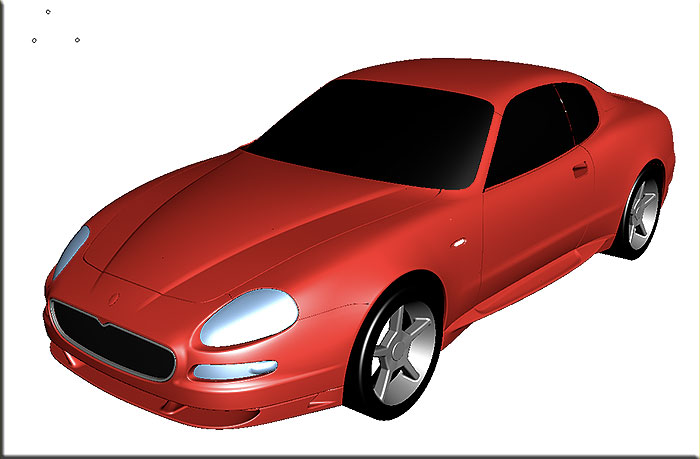 Early spring 2000 class A mathematical surfaces of type M138.
Early spring 2000 class A mathematical surfaces of type M138.
 Rivoli spring 2000. The M138 project in both versions is developed with the help of the virtual room.
Rivoli spring 2000. The M138 project in both versions is developed with the help of the virtual room.
 Key to the set of clearances and tolerances of the M138 Spider typeBoth versions were managed by the same team of Stola and Maserati / Ferrari technicians. Also for these two Type 138s, Beppe Di Nunno was project manager and manager working between Rivoli and Modena.
Key to the set of clearances and tolerances of the M138 Spider typeBoth versions were managed by the same team of Stola and Maserati / Ferrari technicians. Also for these two Type 138s, Beppe Di Nunno was project manager and manager working between Rivoli and Modena.
The design of the spider and coupe version was, as always, under the direction of Italdesign and the Lancia Style Center.
 Partial of the clearance and tolerance diagram of the M138 type
Partial of the clearance and tolerance diagram of the M138 type
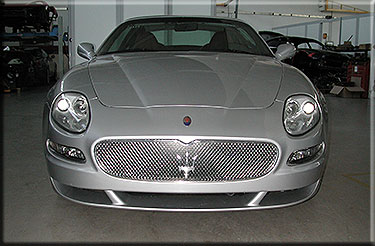

 Modena 2001 Inside the Maserati factory in via Ciro Menotti 322 the first example of the coupé (M138).
Modena 2001 Inside the Maserati factory in via Ciro Menotti 322 the first example of the coupé (M138).
 Paola Busato responsible for Codep at the Frankfurt Motor Show poses for a souvenir photo at the wheel of the Maserati Spider.
Paola Busato responsible for Codep at the Frankfurt Motor Show poses for a souvenir photo at the wheel of the Maserati Spider.
The spider had a shortened chassis in order to better integrate the two-seat layout relative to the coupe’s 2+2.
In September 2001, at the Frankfurt Motor Show, the two Type M138s were unveiled to the press under the names Maserati Spider and Coupè.
 August 2001 Official photo of the Maserati Spider before its presentation at the Frankfurt Motor Show.
August 2001 Official photo of the Maserati Spider before its presentation at the Frankfurt Motor Show.
 Rivoli in Stola s.p.a. November 1995 Alfredo Stola with his Dino 246 GTS poses together with master Aldo Brovarone
Rivoli in Stola s.p.a. November 1995 Alfredo Stola with his Dino 246 GTS poses together with master Aldo Brovarone Turin November 1995. Aldo Brovarone draws the first sketches of the Fiat Stola Dedica at his home.
Turin November 1995. Aldo Brovarone draws the first sketches of the Fiat Stola Dedica at his home. December 1995. One of the very first drawings by Aldo Brovarone.
December 1995. One of the very first drawings by Aldo Brovarone. December 1995. Final drawing by Aldo Brovarone.
December 1995. Final drawing by Aldo Brovarone. January 1996. Mathematics derived from the sketch.
January 1996. Mathematics derived from the sketch. Late January 1996. Aldo Brovarone at work.
Late January 1996. Aldo Brovarone at work.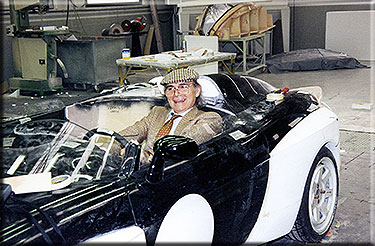 Roberto Stola is the first to test the prototype seat.
Roberto Stola is the first to test the prototype seat. Late January 1996 Aldo Brovarone with the classic Pinifarina-style white coat.
Late January 1996 Aldo Brovarone with the classic Pinifarina-style white coat. 
 Aldo Brovarone, Marco Goffi and Felice Chiara.
Aldo Brovarone, Marco Goffi and Felice Chiara. Rocco Tartaglia with the Ecol forms the sheet
Rocco Tartaglia with the Ecol forms the sheet  Rocco Tartaglia, after having welded the mudguard, makes a first overhaul.
Rocco Tartaglia, after having welded the mudguard, makes a first overhaul. Rocco Tartaglia positions the rear fender.
Rocco Tartaglia positions the rear fender. The new Fiat 2000cc 5-cylinder engine is positioned.
The new Fiat 2000cc 5-cylinder engine is positioned. April 1996. The painting phase.
April 1996. The painting phase.  April 1996. The assembly phase of the mechanics and interiors.
April 1996. The assembly phase of the mechanics and interiors. Rivoli April 21, 1996. In the morning the official photos are taken at the Stola spa.
Rivoli April 21, 1996. In the morning the official photos are taken at the Stola spa.

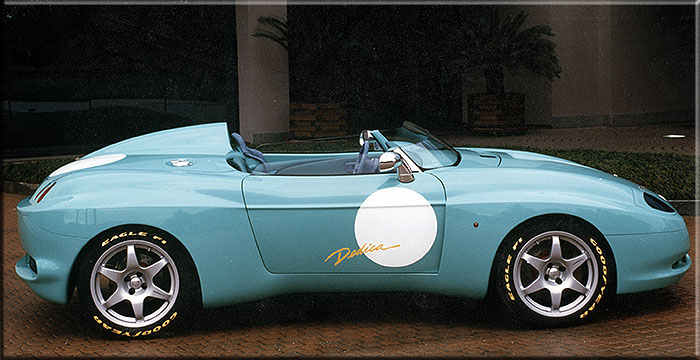
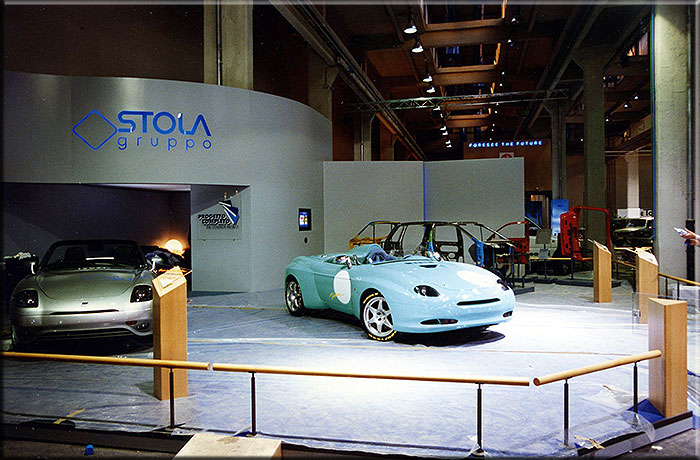 Turin 21 April 1996. The Stola stand the evening before the opening is still under construction.
Turin 21 April 1996. The Stola stand the evening before the opening is still under construction. Turin 22 April 1996. The first day of the show.
Turin 22 April 1996. The first day of the show.  Among the first to admire the Fiat Stola Dedica Fabrizio Giugiaro. Aldo Brovarone and Roberto Stola
Among the first to admire the Fiat Stola Dedica Fabrizio Giugiaro. Aldo Brovarone and Roberto Stola  Villarbasse 10 May 1996. Alfredo Stola covers the first kilometers with the prototype Fiat Stola Dedica.
Villarbasse 10 May 1996. Alfredo Stola covers the first kilometers with the prototype Fiat Stola Dedica. Villa d'Este May 1996. Aldo Brovarone poses with his nephew Cesare next to the Stola Dedica.In May 1996 the Stola Dedica was invited to the Villa d’Este Eleganza competition in the Show Car category. Among the main reasons for this prestigious occasion was the presence of its designer Aldo Brovarone accompanied by his nephew Cesare.
Villa d'Este May 1996. Aldo Brovarone poses with his nephew Cesare next to the Stola Dedica.In May 1996 the Stola Dedica was invited to the Villa d’Este Eleganza competition in the Show Car category. Among the main reasons for this prestigious occasion was the presence of its designer Aldo Brovarone accompanied by his nephew Cesare. Villa d'Este May 1996. The Stola Dedication.
Villa d'Este May 1996. The Stola Dedication. Turin 1996. Aldo Brovarone gives one of HiSense drawings to Cav Rodolfo Gaffino Rossi.
Turin 1996. Aldo Brovarone gives one of HiSense drawings to Cav Rodolfo Gaffino Rossi.






























































